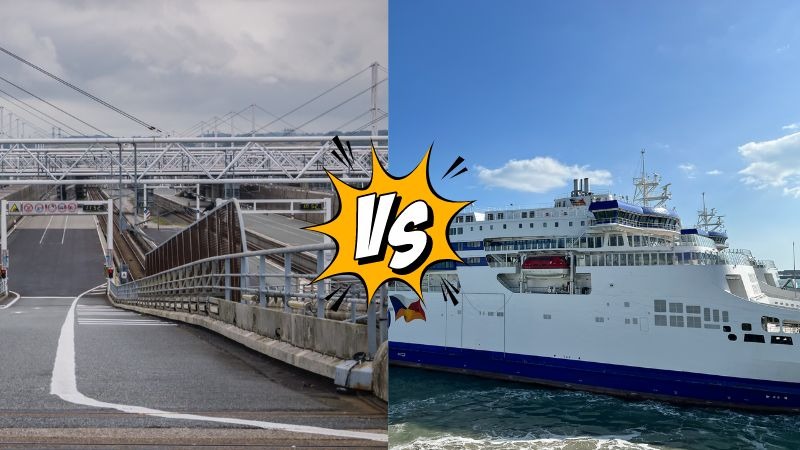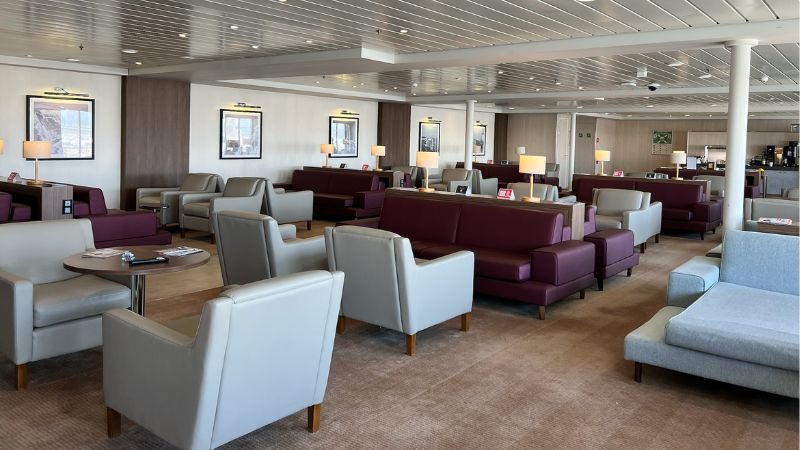Ferry vs Eurotunnel: Travelling by Motorhome or Campervan

When it comes to crossing the English Channel with your campervan or motorhome, the big question is: what's cheaper, faster, and more convenient—taking the ferry or the Eurotunnel? This guide breaks down both options to help you make the best choice for your next road trip adventure.
This post aims to provide a detailed comparison between the two popular methods for crossing the Channel—ferry and Eurotunnel—specifically for campervan and motorhome travellers.
We'll examine key factors such as cost, convenience, travel experience, environmental impact, and more, to help you decide which option best suits your needs.
Overview of Travel Options

Ferry Travel: Traveling by ferry from Dover (UK) to Calais (France) offers a scenic and leisurely crossing experience. Major operators include DFDS, P&O Ferries, and Irish Ferries, all providing reliable services on this popular route. One of the key benefits of ferry travel is the opportunity to enjoy stunning sea views during the journey. For those seeking extra comfort, paid lounges are available as an addon. Additionally, ferries generally offer a lower cost alternative to the Eurotunnel, making it an attractive option for budget-conscious travelers.
Eurotunnel Travel: The Eurotunnel, specifically the Le Shuttle service, provides a fast and efficient way to cross the Channel, with the journey typically being much quicker than by ferry. One of the unique advantages of the Eurotunnel is that you remain in your campervan or motorhome throughout the entire journey, allowing for a seamless and hassle-free experience. This option is ideal for those who prioritize speed and convenience in their travel plans.
Cost Comparison
For a weekend break (Fri 30th of Aug to Sun, 1st of Sep 2024), both options are priced for 2 adults and 1 child, with a campervan up to 6.5m in length.
Prices were checked on 19th August 2024 and may vary.
Ticket Prices:
- Eurotunnel: The standard ticket costs £587, with the "Flexiplus" service available for £256, offering benefits like fast track check-in and flexible travel times.
- Ferry:
- Irish Ferries: £245, or £317 with lounge access. "Flexi" addon is £60.
- DFDS: £328, or £436 with lounge access. "Flexi" addon is £100.
- P&O Ferries: £179.62, with lounge and "Flex" addons ranging from £60 to £146.
Travel Time:
- Ferry: Approximately 1 hour and 30 minutes.
- Eurotunnel: Around 30 minutes.
Convenience & Accessibility
Ease of Booking:
- Eurotunnel: Booking through the Eurotunnel is generally straightforward, with a user-friendly online platform that allows for easy reservation management, including options for quick check-in and adjustments.
- Ferry: Most ferry operators, including Irish Ferries, DFDS, and P&O Ferries, also offer streamlined online booking systems. However, the booking experience can vary slightly between operators, with some offering more flexibility or additional steps, such as selecting onboard amenities during the reservation process.
Travel Time:
- Eurotunnel: The journey takes approximately 30 minutes, making it the fastest option for crossing the Channel.
- Ferry: The ferry crossing takes around 1 hour and 30 minutes, including additional time for boarding and disembarking.
Flexibility:
- Eurotunnel: The "Flexiplus" ticket offers maximum flexibility, allowing travelers to board any train on the day of travel without a fixed schedule, and includes access to premium lounges.
- Ferry: "Flexi" tickets from ferry operators generally allow flexibility within a window of +/- 4 hours from the booked time, depending on availability. This option often includes the possibility of amending or canceling without fees, although terms can vary by operator.
Arrival Time: Both Dover (for ferries) and Folkestone (for Eurotunnel) are busy ports, and it’s recommended to arrive up to 3 hours before your departure to allow time for check-in, security, and boarding procedures.
Onboard Experience

Ferry Experience: Traveling by ferry offers a more leisurely experience with a range of onboard facilities. Depending on the operator, ferries typically include restaurants, shops, and lounges where you can relax during the crossing. For added comfort, some ferries offer paid lounge access, providing a quieter space with premium amenities. Food such as sandwiches, fruits, and snacks, as well as drinks like soft drinks, coffee, and tea, are included in the lounge price. These lounges are usually not too busy, allowing you to relax and enjoy the comfort.
Eurotunnel Experience: The Eurotunnel experience is all about efficiency and convenience. The journey is short—around 30 minutes—and you stay in your campervan or motorhome the entire time, which can be particularly appealing if you prefer privacy or have young children or pets. While the crossing is quick, there aren’t many amenities onboard, as the focus is on getting you across the Channel as swiftly as possible.
Environmental Impact
Carbon Footprint Comparison: When it comes to the environmental impact, both ferry and Eurotunnel services have their own considerations. Ferries, which are larger and slower, tend to have a higher carbon footprint due to the fuel required for the journey across the Channel. In contrast, the Eurotunnel, with its electric trains and shorter travel time, generally produces fewer emissions, making it a more environmentally friendly option.
Sustainability Initiatives: Many ferry operators have started implementing green initiatives to reduce their environmental impact, such as using cleaner fuels and improving energy efficiency onboard. The Eurotunnel has also committed to sustainability, focusing on energy conservation and reducing greenhouse gas emissions as part of its long-term environmental strategy.
Suitability for Different Types of Travelers
Families: For families traveling with children, the ferry might be the more suitable option due to the onboard facilities, including restaurants, lounges, and open decks, allowing kids to move around and enjoy the journey. The longer crossing time also gives families a break from driving, with the chance to relax and even enjoy a meal.
Solo Travelers/Couples: Solo travelers or couples might prefer the Eurotunnel for its speed and efficiency. The quick 30-minute crossing minimizes travel time, allowing more time to explore your destination. Staying in the comfort of your vehicle is also a convenient option, particularly for those looking to maintain privacy or get some rest during the journey.
Pet Owners: For pet owners, both the ferry and Eurotunnel offer pet-friendly services, but the Eurotunnel might be more comfortable for your furry companions. Pets can stay with you in your campervan or motorhome throughout the entire crossing, reducing stress and eliminating the need for separation.
Real User Experiences
Testimonials: Here are a few insights from fellow campervan and motorhome travelers who have experienced both the ferry and Eurotunnel:
- Ferry User: "We loved the ferry crossing with our kids. The open deck and lounge made the trip enjoyable and relaxing. The views were fantastic, and it gave us a nice break from driving."
- Eurotunnel User: "The Eurotunnel was a game-changer for us. The quick journey and staying in our motorhome made it super convenient, especially with our pets. We were on the road again in no time."
Case Studies:
- Short Weekend Trip: A couple using the Eurotunnel for a quick weekend getaway appreciated the efficiency and speed, allowing them more time to explore their destination.
- Extended European Tour: A family on a longer European tour chose the ferry for its relaxed pace and onboard amenities, making the journey part of their vacation experience.
Conclusion & Recommendation
Summary: When it comes to crossing the English Channel with your campervan or motorhome, both the ferry and Eurotunnel have their unique advantages. The ferry offers a leisurely experience with onboard amenities, making it ideal for those who enjoy the journey as part of their adventure. On the other hand, the Eurotunnel provides speed and efficiency, perfect for travelers who prioritize getting to their destination quickly.
Recommendation: If you're traveling with family and want to enjoy the journey, the ferry might be your best bet. However, if you're focused on minimizing travel time, the Eurotunnel is the way to go.
Call to Action: We’d love to hear your experiences! Share your thoughts in the comments below or reach out with any questions you have about planning your next road trip.
FAQs
What is the best option for quick travel?
- Eurotunnel is faster, taking around 30 minutes.
Which option is more budget-friendly?
- Generally, ferry tickets are cheaper, especially with basic services.
Can I travel with pets?
- Yes, both options are pet-friendly, but Eurotunnel allows pets to stay with you in your vehicle.